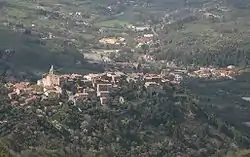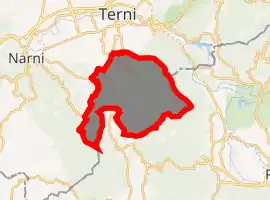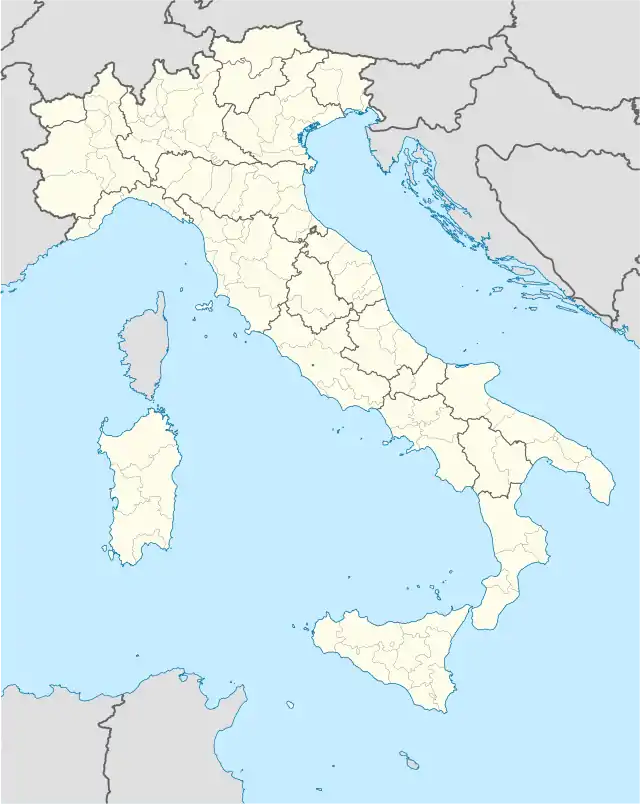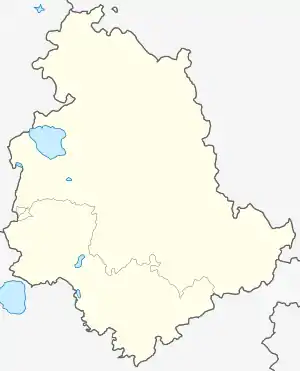Stroncone
Stroncone is a comune (municipality) in the Province of Terni in the Italian region Umbria, located about 70 km southeast of Perugia and about 8 km south of Terni.
Stroncone | |
|---|---|
| Comune di Stroncone | |
 | |
 Coat of arms | |
.svg.png.webp) Stroncone within the Province of Terni | |
Location of Stroncone 
| |
 Stroncone Location of Stroncone in Italy  Stroncone Stroncone (Umbria) | |
| Coordinates: 42°30′N 12°40′E | |
| Country | Italy |
| Region | Umbria |
| Province | Terni (TR) |
| Frazioni | Aguzzo, Coppe, Finocchieto, Vasciano |
| Government | |
| • Mayor | Alberto Falcini |
| Area | |
| • Total | 71.17 km2 (27.48 sq mi) |
| Elevation | 451 m (1,480 ft) |
| Population | |
| • Total | 4,917 |
| • Density | 69/km2 (180/sq mi) |
| Demonym(s) | Stroncolini or Stronconesi |
| Time zone | UTC+1 (CET) |
| • Summer (DST) | UTC+2 (CEST) |
| Postal code | 05039 |
| Dialing code | 0744 |
| Website | Official website |
Geography
Located in southern Umbria, nearby the borders with Lazio, the municipality borders with Calvi dell'Umbria, Configni (RI), Cottanello (RI), Greccio (RI), Narni, Otricoli, Rieti (RI) and Terni.
It counts the hamlets (frazioni) of Aguzzo, Coppe, Finocchieto and Vasciano.
History
Although some have wanted to identify the site ofStroncone is home to that of the ancient Roman town of Trebula Suffena, there is no reliable documentation for this. It is probable, however, that the settlement has arisen during the Middle Ages, perhaps starting with a small defensive element, a sighting tower guarded by some important aisles important for that time. Stroncone was, in fact, in a border area between the Longobard Duchy of Spoleto and the territory under the control of the Byzantines. Right from the name of one of the Dukes of Spoleto, Ugo, it would derive that of the center, obtained from the original "castrum Hugonis", corrupted in "Castrugone", "Strungone" and finally "Stroncone".
The first document attesting to the existence of the residence dates back to 1012, when Giovanni di Pietro gave to the monastery of San Simeone his possessions located in the territory of Stroncone, the houses and casalini that he owns within the "castle" of Stroncone and his portion of the church of Sant'Angelo, which is called "oratory" on this date.
The documents from the XI century confirm the existence of a well-defined settlement, a true castle, with fortifications and walls, inside which there are houses, a square, and worship buildings. During this period, Stroncone is gravitating to Narni's orbit, as well as being part of the diocesan territory of this city. In order to counter the expansive policy of the municipality of Narni, perpetually disputed with the municipalities of Terni and Rieti, and with the aim of restructuring the Pontifical State, Innocent III will grant Stroncone municipal autonomy in 1215 (LANZI 1895). From this moment on, the policy of the center will always follow the guelph side so much that on the coat of arms of the commune appear the white cross on red background and the pontifical keys. Stroncone is next to Narni in supporting the Pope's army against the imperial troops of Frederick II of Swabia, supported by the municipality of Terni. With the 14th century the town, still following the destiny of Narni, appears ruled by the rectors of the Pontifical State (Ugo Augeri, Bernardus De Lacu, Pietro di Vico, Girolamo Orsini, Francesco Orsini, Nicola Orsini). 'Avignonese exile of the popes, vicars of the Holy See who govern through a commissioner.
In January 1378, the municipality of Stroncone, a small "walled wall" in the diocese of Narni, was recognized by Gregory XI as the privilege of land immediately subject to the Holy See, an area of freedom which was then confirmed to him at the beginning of ' modern age by Leo X. According to Lanzi, in 1394 the fort was occupied by Pandolfo Malatesta and in 1404 by Andrea Tomacelli: on this latter occasion the fortress would have been partly destroyed by Stronconesi himself to get rid of the stately garrison and subsequently rebuilt, although it is true that in 1493, at the passage of Pius II Piccolomini, the place was still "very full".
It is probable that Stroncone, along with other Guelphic parts centers such as Narni and Miranda, suffered significant damage during the passage of imperial troops, the Lanzichenecchi, in 1527. The signs of subsequent reconstruction are still evident in many buildings, especially in the isolation of the municipal building and in the walls. The political and economic influence of the minor brothers in the life of the city from the fifteenth century should not be forgotten, so as to favor Stroncone as in the main centers of Umbria, the birth of a mountain of Pietà (1466) and of a Monte Frumentario (1489) with the aim of combating illicit and immoral economic activities.
In the sixteenth century the land was ruled by the cardinals of the Sacred College through the office of the podestà, while by the end of the sixteenth century, with the administrative reform of the papal state introduced by Sisto V, the center was submitted directly to the Apostolic Chamber, from the pontiff himself and was governed by a resident apostolic commissioner. For this reason, as in other centers of the papal state (see the case of Rieti and Terni), beside the aisle palace, the headquarters of the local government, was built the apostolic palace, the peripheral seat of the central government, with the residence of the governor and the annexed jails, an expression of the judicial power that the governor exemplified. The population of the castle, which at the end of the fifteenth century was composed of just five hundred souls. While the countryside did not reach six hundred fireplaces, it was not divided into territorial divisions, but in the two parishes of Sant'Angelo and San Nicolò. While there were no parochial boundaries, the two colleges had mixed care and also "in the funeral one acted and exercised the other's care."
In the town there is also the presence of three confraternities: in the square of San Giovanni there was the Society of Mercy for hospitalling purposes (it was in fact the San Rocco hospital); near the piazza della Rocca, the Compagnia del Gonfalone, directed by the Friars Minor; the Brotherhood of the Sacrament at Santa Maria di Piazza, then called San Giovanni Vecchio and finally Santa Maria della Porta, all of which are aggregated to the namesake archconfraternities of Rome.
Among the most significant events of the modern age, the resistance sustained by the inhabitants of Stroncone against the French troops of Napoleon, which penetrated the town walls only after a siege of seven days and deceit, was remembered. Since it became the town hall of the Kingdom of Italy, Stroncone was united to the municipality of Terni in 1929. Only after the Second World War in 1947 it regained its administrative autonomy.
Main sights
Personalities
- Asprilio Pacelli (1570-1623), Baroque composer, born in the hamlet of Vasciano
Transport
Stroncone has a stop on the Terni–Sulmona railway, with trains to Terni, Rieti and L'Aquila.
See also
- 5609 Stroncone
References
- "Superficie di Comuni Province e Regioni italiane al 9 ottobre 2011". Istat. Retrieved 16 March 2019.
- All demographics and other statistics: Italian statistical institute Istat.
- "Popolazione Residente al 1° Gennaio 2018". Istat. Retrieved 16 March 2019.